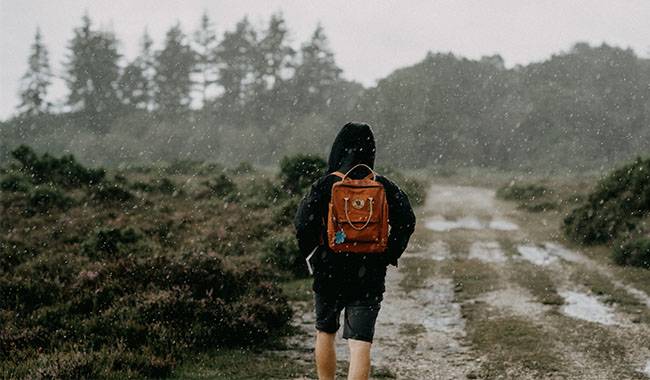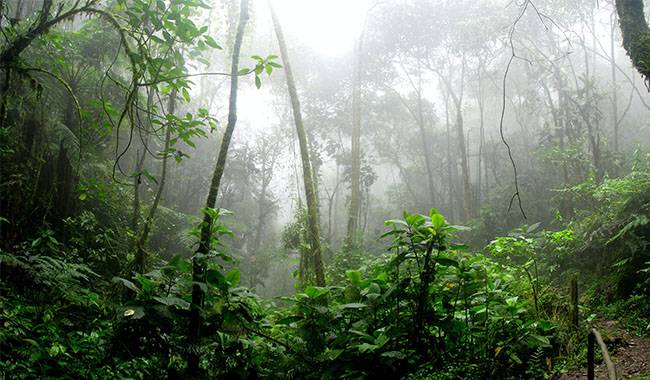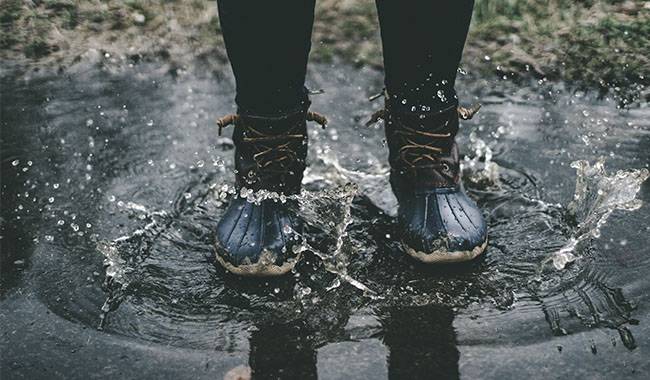
If you don’t want to get rained on in the mountains, don’t go camping. You can’t avoid it otherwise, but you can prepare for it. The first and most important thing to do is to be prepared to get wet while hiking. Understand that rain is the norm in the mountains and you can’t immediately hide under the eaves, dry your clothes on the heater, and put on wet boots in the morning. If you’re not someone who tolerates the vagaries of nature, here’s what you need to do to make sure the rain doesn’t become a disaster. You will learn more about How to Don’t Feel Bad When Hiking in The Rain by LCN Outdoors article.
Get The Right Equipment
This is a good time to remember the adage ‘no weather is bad, no clothes are bad’. Modern hiking clothing and equipment can make camping conditions more comfortable, even in the rain. Here’s a list of things that can help keep you out of the rain, including your health.
A. Waterproof clothing
A jacket and long pants to wear when it rains. Modern membranes can withstand hours of continuous rainfall without making you feel like you’re in a sauna because of the breathability of the material. To learn how it works, what membranes are available, and what you need when camping, read our related article on how to choose. A membrane jacket and long pants won’t help you love camping in the rain, but you will feel dry and warm.
B. Rain jacket or poncho
If you’re going to an area known for particularly frequent rainfall, make a point of getting a poncho or vest. They are made of a material that is completely waterproof but not breathable. They’re not very comfortable to walk in, but they guarantee you won’t get wet.
There are sturdy rain jackets with hoods that will protect both you and your backpack. The only downside is that they are heavy. If weight is a concern, you can buy a regular polyethylene raincoat. It’s not heavy, it definitely won’t get wet, and it’s even warm because it’s not breathable. It tears easily, though, so it’s not suitable for hiking in forested areas. It’s best to bring a few of these for backup.
C. Poncho on backpack
Sometimes it comes with a backpack, but not always – if it doesn’t, check and buy one. After each trek, check the cape for cuts and tears. The hole in the cape is useless, so be sure to glue it up or buy a new one before camping.
Backpacking ponchos combined with membrane jackets offer good rain protection, mobility, and versatility of use. The poncho covers you along with your backpack and prevents water from getting between your back and your pack.
D. Synthetic clothing
Cotton T-shirts and pants get wet in the rain and are difficult to dry out. This is especially true of socks. Modern hiking clothing lines have more models made of synthetic fibers that don’t retain water and dry quickly on your body as you move.
In addition to membrane clothing, synthetic thermal underwear, fleece jackets, lightweight softshell pants, and synthetic hiking socks are the perfect equipment for a rainy day camping. Fleece can be thoroughly wrung out, is almost dry, and is warm even when wet.
E. Shoe covers, lantern boots
They are usually used to keep snow out of your shoes, but they can also keep you out of the rain. In heavy rain, if your boots are not covered by long pants (such as shorts or tights), water can quickly get in through the cuffs, and waterproof tights can prevent this from happening.
F. Waterproof socks
A mast for those who can’t stand the feeling of wet feet. Membrane socks keep your feet dry and warm, even if you have to put on wet and cold boots in the morning. Some people use neoprene socks, but they have many disadvantages. They don’t breathe, so your feet will still be wet, and they’re not tight and always slip off, so there’s a big risk of wear and tear.
G. Sealed packaging
A backpack cover is not 100% waterproof – it can tear, get lost, or in heavy rain, water can enter the pack through unseen gaps. Therefore, the most valuable things should be in a sealed bag: documents, money, a phone, and most importantly, a sleeping bag. Even if absolutely everything is wet, having a dry sleeping bag is enough to get a good night’s sleep.
Airtight packaging is available for everything from clothes, gadgets, and documents to bags and pouches of all sizes. Learn more about the what and why of it in our article “Choosing a Ziploc Bag”.
H. Pajama Sets
You should sleep in dry clothes only, so bring a change of clothes. The best choice is a set of thermal underwear, wool underwear is fine. Sleeping gear is best kept in a sealed bag with your sleeping bag and only taken out when you are camping. You won’t need them in camp – it’s warm on the move, even if all your clothes are wet. But as soon as you set up your tent, you’ll have to change your clothes. Of course, it’s best not to go out in the rain in these dry clothes, and if you do, only wear a jacket or vest.

Setting Up Camp Correctly
When it rains, you want to set up your tent and take shelter. It doesn’t make sense to choose a comfortable open space. But it’s worth thinking ahead about how to set up a comfortable and safe campsite in bad weather to avoid unpleasant surprises. Here are a few simple rules to prevent rain and camp comfortably.
A. Assess the safety of the accommodation
A group of tourists is camping on a small island between two creek beds. They want to stay near the water and the place is beautiful. During the night, it started to rain heavily and the island was flooded. In the middle of the night, we had to practically swim to save the camp and move it up the slope. As a result, the campers and all their belongings got soaked.
This island of grass between the riverbeds is beautiful but dangerous. Don’t stand near the water, and don’t stand on a low-lying, dry riverbed – even a dry river can become full-flowing after a downpour. When choosing a camping site, be sure to consider what will happen if it rains heavily and where the water will flow.
B. Open the vents inside the tent
When it’s raining and windy, some first-time campers close the vent windows to keep water droplets out of the tent and to keep it warm. This is a big mistake. Without ventilation, you may wake up in the morning to a puddle of water caused not by rain, but by a closed window. Make sure you keep the windows open so the rain doesn’t pour through them because they have protective netting. If a few drops of water happen to get in, that’s better than condensing into a river.
C. Take an awning
If it starts to rain heavily on the trail, you can quickly stretch your tent and wait out the weather under it without having to take out your tent. It’s also ideal for camping: when it’s raining, it’s good for cooking, eating, and just gathering together instead of scattering in your tent. You can hang your wet clothes under your tent, which is better than leaving them in the tent, and they dry faster in the open air.
It’s easy to set up under a tent in the rain. This is especially true if the inner tent is set up first and then the canopy, which is the case with most modern tents. With this structure, the “inside” gets wet quickly, so the tent canopy is very useful.
Setting up an awning does not require trees. It can be stretched over trekking poles – it will be lower, but it will do the main task.
Dry Things Out As Much As Possible
After a night of rain, wet tents, condensation-soaked sleeping bags, jackets, boots, and socks that have not dried overnight – all of these things must be put in your backpack or put on in the morning. Putting on wet clothes is unpleasant, but only for the first few minutes. During the move, the body warms up quickly and the clothes dry directly on the body. Everything in your backpack should be dried as soon as possible.
In the bright summer sun, it takes no more than an hour for any item to dry. If the sun comes out after a long period of rain, you should take a long enough break to get your tent, sleeping bag, and tent out of your backpack and dry them out. Even without the sun, everything dries faster in the air than in a backpack. Smaller items like socks and T-shirts can be dried on the move, for example, by hanging them from your backpack-not pretty, but quick drying.
These boots also dry well in the sun. Even for a short 15-minute break, you can take them down and expose them to the sun. For longer breaks, such as during lunch, you should untie the boots, open them up as much as possible, remove the insoles and leave them in the sunlight like this. Boots with textile linings dry the fastest, and full leather boots take the longest to dry.

Make Sure The Route Is Safe
It is up to the leader to decide whether to walk in the rain or not. If it rains in the middle of the day, not too much, and the trail is well-traveled, you will usually keep going. But sometimes it’s worth stopping and staying in camp. Not only because you don’t want to get wet, but also for safety reasons.
A. Wait for the storm to pass
A thunderstorm is especially dangerous if it catches you high up in the mountains, on top of a hill or ridge. Since it never starts suddenly, there is usually time to assess the situation and turn to safety. During a thunderstorm, you should stay as low as possible, out in the open, and not under lonely trees or near large rocks.
If a thunderstorm is approaching – lightning and thunder are only a few seconds apart – put away all metal objects. Sticks, ice picks, utensils, and all possible “iron” items should be stacked no more than 65-100 feet (20-30 meters) from the group.
B. Do not cross dangerous shallows
When it rains, the water level rises rapidly and a small river becomes a monstrous torrent in an instant. If possible, delay crossing, or look for a place where the current is weakest. Remember to unbuckle your pack when crossing – this will make it easier to get out of the load if you do fall into the water.
C. Avoid slippery terrain
In all weather, it is safe to walk on good trails. On the other hand, it’s easy to slip and get hurt in the rain on wet rocks and grass. So, before you venture out in the rain on difficult terrain, assess the risks: what will you fall on, and is it best to wait until it dries out? Rocks and boulders dry quickly in the sun.
Tip: On sports hikes, hikers wear hiking jackets to walk up steep slopes with wet grass. It looks ridiculous, but it’s safe. Of course, you don’t need to intentionally carry them “just in case”, but if they are in your backpack on the route, you can use them not only on the glacier.
D. Finding Shelter
If it rains heavily, the terrain is complicated and you decide to wait in the rain, be sure to find shelter. In mountainous areas, the temperature drops dramatically when it rains, and wet clothes and wind can quickly lead to hypothermia. If possible, it is worth putting up at least one tent per group – 10-12 people can easily fit in a “three-person” tent. If this is not possible, it is a good idea to set up a tent, hide under it, and make hot tea.
To Summarize
- Please be prepared, in the mountains, rain is the norm.
- Bring waterproof clothes.
- Put a sleeping bag and a sleeping set in a ziplock bag. Put your cell phone, documents, and money in a separate Ziploc bag.
- Before setting up camp, consider whether you will be flooded in case of rain. Open the vents inside your tent – the wind is better than condensation.
- Bring a group tent – it’s warmer and more fun for the whole group to hide from the rain.
- If the rainfall is prolonged, dry off early. Any ray of sunshine is a good excuse to take a break and dry the wet stuff in your pack.
- It is up to the hiking guide to decide whether to walk in the rain or not. Good trails in the valley can be hiked in almost any weather. However, slippery difficult terrain, stormy rivers, and mountain thunderstorms can be dangerous – it’s best to wait for the elements to calm down.
Have a great day on the trail and lots of sunny days!
When some one searches for his essential thing, therefore he/she desires to be available that in detail, so that thing is
maintained over here.